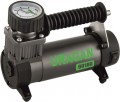The capacity of the compressor (see "Type") is the maximum amount of air that it can pump into the tyre in a minute.
Higher performance reduces the time required to inflate the wheel; on the other hand, this parameter directly affects the dimensions, weight, power consumption and price of the compressor. So it is worth choosing according to performance, taking into account real needs. So, for a “duty” tyre inflation in a passenger car, a compressor with a low operating speed is quite enough — up to
20 L / min inclusive. And if the speed of full pumping is also important for you (for example, after replacing the rubber) — you can choose a unit for
21 – 40 L / min. In turn, models with more solid characteristics —
41 – 60 L / min and
more — are intended mainly for heavy equipment like SUVs, trucks, tractors, etc.
Separately, it should be noted that this parameter is NOT suitable for calculating the exact inflation time (even if the exact volume of air in the wheel is known). The fact is that the actual performance of the compressor is always lower than the claimed one: the figures in the characteristics are indicated for free air outlet, and when pumping the wheels, the pumping speed will inevitably be lower due to the resistance of the nipple.
The length of the hose through which air is pumped into the tyre. The larger it is, the more convenient the device is to use. But it is rare that the compressor is left far from the wheel, especially if a pressure gauge is placed on the device, which must be periodically checked. For domestic use in cars, a one and a half metre long hose is enough. Powerful and performant models can be equipped with a hose of 7 metres or more, but these are more solutions for commercial use in car services.

